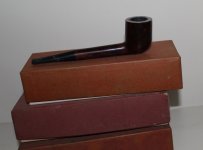I feel sorry right now for the folks who think 3 dollar drug store pipes are the epitome of something.
This was a five dollar Marxman Super Briar pipe, back when drug store pipes were a dollar, and London best pipes were $15.
View attachment 202563View attachment 202564
View attachment 202565View attachment 202566
View attachment 202568
Genuine Pre War of Algerian Independence briar was the epitome of soft, porous, well cured and extra aged briar for luxury pipes.
But it had such a bad reputation for plainness of grain Marxman used Algerian briar, but didn’t usually advertise it.
There might be a hot, wet, bad smoking Algerian briar pipe, but I’ve not found one yet.
Try one. They only cost about twenty bucks for a good example.








